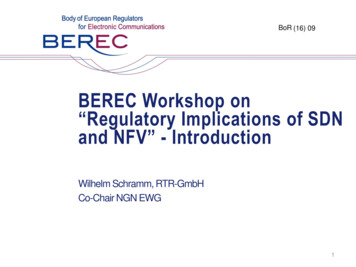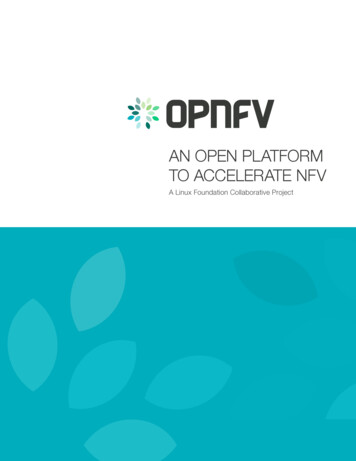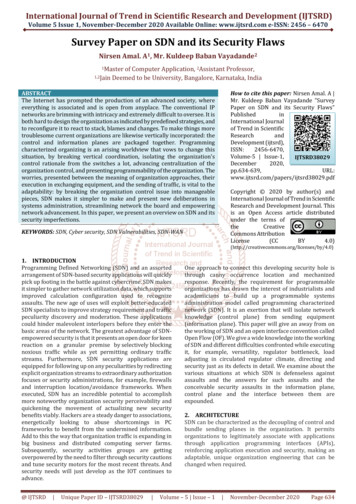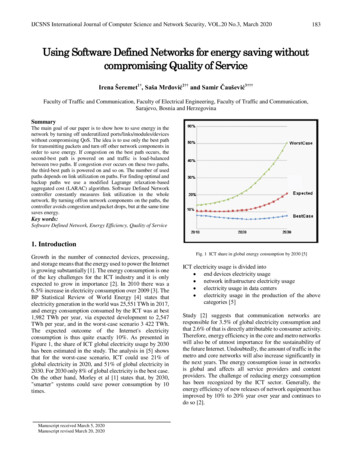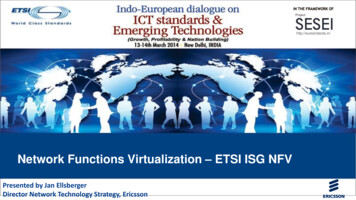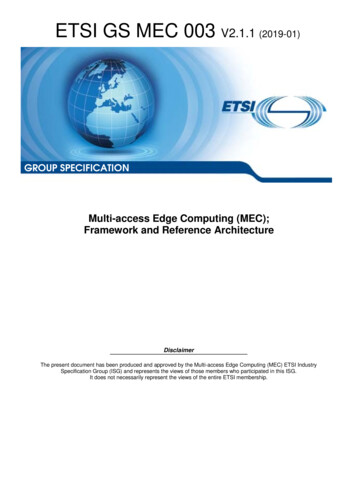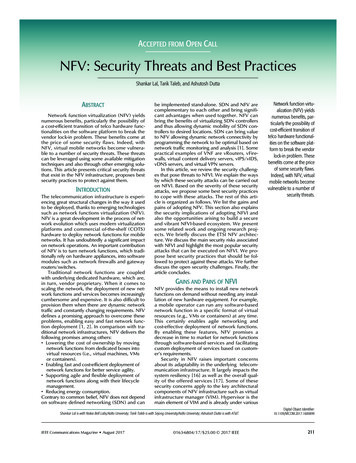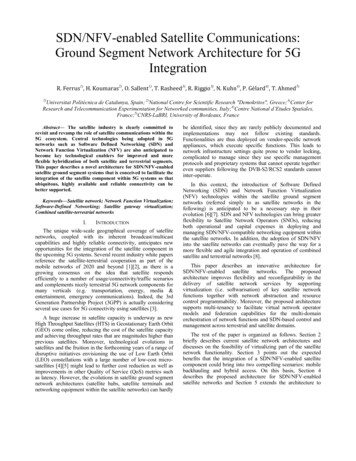
Transcription
SDN/NFV-enabled Satellite Communications:Ground Segment Network Architecture for 5GIntegrationR. Ferrus1), H. Koumaras2), O. Sallent1), T. Rasheed3), R. Riggio3), N. Kuhn4), P. Gélard4), T. Ahmed5)1)Universitat Politècnica de Catalunya, Spain; 2)National Centre for Scientific Research "Demokritos", Greece;3)Center forResearch and Telecommunication Experimentation for Networked communities, Italy;4)Centre National d’Etudes Spatiales,France;5)CNRS-LaBRI, University of Bordeaux, FranceAbstract— The satellite industry is clearly committed torevisit and revamp the role of satellite communications within the5G ecosystem. Central technologies being adopted in 5Gnetworks such as Software Defined Networking (SDN) andNetwork Function Virtualization (NFV) are also anticipated tobecome key technological enablers for improved and moreflexible hybridization of both satellite and terrestrial segments.This paper describes a novel architecture for SDN/NFV-enabledsatellite ground segment systems that is conceived to facilitate theintegration of the satellite component within 5G systems so thatubiquitous, highly available and reliable connectivity can bebetter supported.Keywords—Satellite network; Network Function Virtualization;Software-Defined Networking; Satellite gateway virtualization;Combined satellite-terrestrial networksI.INTRODUCTIONThe unique wide-scale geographical coverage of satellitenetworks, coupled with its inherent broadcast/multicastcapabilities and highly reliable connectivity, anticipates newopportunities for the integration of the satellite component inthe upcoming 5G systems. Several recent industry white papersreference the satellite-terrestrial cooperation as part of themobile networks of 2020 and beyond [1][2], as there is agrowing consensus on the idea that satellite respondsefficiently to a number of usage/connectivity/traffic scenariosand complements nicely terrestrial 5G network components formany verticals (e.g. transportation, energy, media &entertainment, emergency communications). Indeed, the 3rdGeneration Partnership Project (3GPP) is actually consideringseveral use cases for 5G connectivity using satellites [3].A huge increase in satellite capacity is underway as newHigh Throughput Satellites (HTS) in Geostationary Earth Orbit(GEO) come online, reducing the cost of the satellite capacityand achieving throughput rates that are magnitudes higher thanprevious satellites. Moreover, technological evolutions insatellites and the fruition in the forthcoming years of a range ofdisruptive initiatives envisioning the use of Low Earth Orbit(LEO) constellations with a large number of low-cost microsatellites [4][5] might lead to further cost reduction as well asimprovements in other Quality of Service (QoS) metrics suchas latency. However, the evolutions in satellite ground segmentnetwork architectures (satellite hubs, satellite terminals andnetworking equipment within the satellite networks) can hardlybe identified, since they are rarely publicly documented andimplementations may not follow existing standards.Functionalities are thus deployed on vendor-specific networkappliances, which execute specific functions. This leads tonetwork infrastructure settings quite prone to vendor locking,complicated to manage since they use specific managementprotocols and proprietary systems that cannot operate together:even suppliers following the DVB-S2/RCS2 standards cannotinter-operate.In this context, the introduction of Software DefinedNetworking (SDN) and Network Function Virtualization(NFV) technologies within the satellite ground segmentnetworks (referred simply to as satellite networks in thefollowing) is anticipated to be a necessary step in theirevolution [6][7]. SDN and NFV technologies can bring greaterflexibility to Satellite Network Operators (SNOs), reducingboth operational and capital expenses in deploying andmanaging SDN/NFV-compatible networking equipment withinthe satellite networks. In addition, the adoption of SDN/NFVinto the satellite networks can eventually pave the way for amore flexible and agile integration and operation of combinedsatellite and terrestrial networks [8].This paper describes an innovative architecture forSDN/NFV-enabled satellite networks. The proposedarchitecture improves flexibility and reconfigurability in thedelivery of satellite network services by supportingvirtualization (i.e. softwarisation) of key satellite networkfunctions together with network abstraction and resourcecontrol programmability. Moreover, the proposed architecturesupports multi-tenancy to facilitate virtual network operatormodels and federation capabilities for the multi-domainorchestration of network functions and SDN-based control andmanagement across terrestrial and satellite domains.The rest of the paper is organized as follows. Section 2briefly describes current satellite network architectures anddiscusses on the feasibility of virtualizing part of the satellitenetwork functionality. Section 3 points out the expectedbenefits that the integration of a SDN/NFV-enabled satellitecomponent could bring into two compelling scenarios: mobilebackhauling and hybrid access. On this basis, Section 4describes the proposed architecture for SDN/NFV-enabledsatellite networks and Section 5 extends the architecture to
coveer the case of integratedd satellite-terrrestrial netwworks.Finaally, main concclusions are drrawn in Sectioon 6.II. VIRTUAALIZATION OFF SATELLITE NETWORKSA. CurrentCsatelliite network arrchitecturesFig.F 1 illustraates a generall reference modelmfor a multimgatewway satellite ground seggment for saatellite broaddbandcommmunications [9][10]. It is structuredd in three mainsubssystems:-Thee access subsyystem, commonly referred to as the sattelliteacceess network. ThisT includes thhe satellite gatteways (GWs)) andthe satellitesterminnals (STs), whhich are intercconnected thrroughthe resource of oneo or severaal channels (ttransponders) of ammunication saatellite.com-Thee core subsysteem, commonly referred to asa the satellitee corenetwwork. This is an aggregatiion network that interconnnectsdiffeerent satellite GWsGlocated in the same or different sattellitehub//teleport faciliities as well asa the networkk nodes locateed insomee Points of PPresence (PoPPs) to intercoonnect with otheroperrators, corporaations and Inteernet Service ProvidersP(ISPPs).-Thee control annd managemeent subsystemms, composedd ofnetwwork elementss such as the NetworkNConttrol Centre (NNCC)and the Networkk Managemennt Centre (NNMC), the foormerviding real-timme control ofo the satellite network (e.g.provconnnection controol including thhe signaling neecessary to seet up,supeervise and releease connectioons) and the latter in chargge ofthe managementmoof the system elementseof thhe satellite netwwork(e.g. fault, configuration, accounting,apperformance,andurity managemment).secuA satellite GWW typically comprises: thhe Out-Door Unit(ODDU), composed of the anteenna and radiio head unitss; theSatellite Basebandd Gateway (SSBG) subsysteems, composeed ofFLLink (FL) subsystem and thhe Returning Linkthe Forwarding(RL)) subsystem fofor satellite acccess and transsmission; and a setof Satellite Netwoork Functions (SNF), in chharge of the L2/L3Lwith the satelllite core netwwork as well asa ofinterrconnection wdiffeerent Performmance Enhanccing Proxy (PPEP) functionns toimprrove the higheer layer protoccols performannce.typiccal GEO sattellite GW. For a LEO constellationn, thefuncctional GW modelmwould beb similar, inccluding only a fewotheer specific additionnalacoontrol functions such ass themannagement of handovers.hThhis architecturre is based onn theauthhors’ interpreetation of thhe DVB-S2 and DVB-RRCS2normmative documments. Three potential variants for the splitbetwween VNFs anda Physical NetworkNFunnctions (PNFss) areillusstrated in Fig. 2 by red-dottted lines. For each variannt, theproccesses below the red-line wouldwbe impplemented as PNFsP(i.e. embedded withinwspecialiized hardwaree), while the onesould be suppllied as VNFss (i.e.abovve the red-dootted line woexeccuted in a NFFV Infrastruccture Point off Presence [NNFVIPoP] with generic hardware). The relevannce of selectiing apends on the fronthaulflink characteristiccs andvariaant mostly depthe interaction betweenb(1) the functionns that couldd benentity (2) and thosee thatcenttralized in onee or several networkare distributed in the satelllite gatewayss. Without beingbcondditioned to anyy particular vaariant, in the followingfthe VNFimpllementation ofo the SNFs shown in Figg. 2 is generiicallydenooted as SNF-VVNF. Likewise, the VNF implementatioon ofpart of the SBGG is denoted as SBG-VNNF. And the nonvirtuualized part ofo the SBG isi denoted ass SBG-PNF. MoreMinformation on the suitabiliity of the ddifferent poteentialdecoompositions caan be found inn [11].Fig. 1.1 Reference arcchitecture for a tyypical multi-gatewway satellite netwworkB. VirtualizationVof satellite gaatewaysGivenGtheir ceentral role in thhe satellite nettwork, the sattelliteGW is the mostt crucial commponent. Keyy drivers forr theualization of satellitesGWs are similar too those behindd thevirtuvirtuualization of mobile radioo access netwworks (e.g. CloudCRadiio Access Nettwork and virrtualization off small cells). Theultimmate aim is too enable the creationcof an environment withfullyy virtualized capabilities allowingamultii-tenancy, flexibleinstaantiation, orchhestration andd managementt of resourcess andfuncctions. In this regard, the concept of Sattellite Cloud RANR(Sat--Cloud-RAN) is defined tot refer to thhe applicabilitty ofNFVV techniques too satellite GWWs so that mosst of their funcctionscan be run as onee or more Virttual Network Functions (VNVNFs)gose compute platforms, leeaving only veryon general-purpospeccific functionaality to be run on specific haardware appliaancesfor thhe sake of perrformance.Fig.F 2 providees a more detaailed view of the main dataa andconttrol plane funnctions that arre generally inntegrated withhin aFig. 2.2 Main functionns within the datta and control pllanes of a satellitte GWand possible VNNF-PNF decompoosition variants
III. INTEGRATION SCENARIOSTwo compelling scenarios that will benefit from theintegration of satellite and terrestrial networks throughSDN/NFV-based technologies are described in the following.A. 4G/5G satellite backhauling servicesIn addition to service extension in remote or hard to reachareas, a tighter integration of satellite backhauling services in4G/5G mobile networks can be instrumental to facilitate moreefficient traffic delivery to radio access network (RAN) nodes(e.g. the satellite link can be used to offload multicast/broadcasttraffic such as TV live streams addressed to multiple cell sites),increased resilience and support for fast, temporary celldeployments and moving cells [12][13].Building on the enhanced flexibility (e.g. bandwidth ondemand) and satellite network service customization (e.g.selectable set of satellite VNFs) capabilities brought bySDN/NFV-enabled satellite networks, MNO’s are expected toimprove the level of control and management of satellitebackhauling services through programmable interfaces forresource management and control. This must allow the MNOto simplify integration and management of satellite networkservices to satisfy its time- and location-dependent backhaulingneeds. This must also allow the MNO to be able to dynamicallyand flexibly provision and configure satellite network serviceswith specific network functions (e.g. PEP, firewalling, etc.).From the SNO side, this scenario could also lead into anextended role of the SNO that, in addition to providing satelliteconnectivity, could be also participating in the value chain ofMobile Edge Computing (MEC) services and cellular tral/wholesale RAN shared nodes (e.g. multi-tenant smallcells bundled with satellite connectivity).B. Satellite-terrestrial hybrid access servicesHybrid access networks are those combining a satellitecomponent and a terrestrial component in parallel [10]. Such acombination can improve service delivery in areas whereQoS/QoE delivered by terrestrial access alone may be notsatisfactory (e.g. higher speed broadband Internet access in lowdensity populated areas with limited xDSL or fiber coverage[14]).One promising approach to address the integration ofsatellite and terrestrial networks for hybrid access is federation.Federation refers to the pooling of network resources from twoor more domains in a way that slices of network resourcesdistributed across the different domains can be created andused as one logical domain enabling easier control of theresources [15]. Federation of network resources inheterogeneous and multi-domain scenarios is currently beingaddressed in several EU research projects (e.g. FELIX, FI-PPPXIFI, and FP7-NOVI). The expected development offederation capabilities in satellite communications is regardedas pivotal for providing additional resources, features andservices by SNOs to customers.Reconfigurability, evolvability and programmability arethree key characteristics that can facilitate the achievement ofthe federation challenge, while SDN and NFV are the mostpromising enabling technologies. By embracing SDN, thesatellite network can expose a vendor-neutral, universallysupported open interface, enabling unified management withterrestrial networks. Similarly, the NFV techniques simplifythe provision of value-added networking services in thesatellite communications systems, by expanding the terrestrialNFV management framework to satisfy the needs of thesatellite domain as well. This is in line with the 5G vision,which encompasses federation of heterogeneous accessnetworks in a transparent manner [16]. Federation could alsocreate a new market, where the federation from a businessperspective is supported by a third party e.g. a broker, whichoffers added value federated network services supported by theunderlying federated networks.IV. ARCHITECTURE OF SDN/NFV-ENABLED SATELLITENETWORKSA high-level view of the proposed architecture forSDN/NFV-enabled satellite ground segment systems is givenin Fig. 3 and explained in the following.A. Physical network infrastructureAs depicted in Fig. 3, the physical network infrastructure isassumed to consist of the following elements:- NFVI-PoP(s) for SNF-VNFs. This infrastructure might not benecessarily located close to the satellite hub premises. Themain resources in this NFVI-PoP are network, computing(CPU) and storage. Additionally, certain VNFs may requirespecific NFVI resource requirements, such as hardwareaccelerators (e.g. IPSec specific hardware).- NFVI-PoP(s) for SBG-VNFs. This represents thevirtualization infrastructure over which the satellite basebandgateway functions would be deployed. This infrastructure islikely to be located in or close to the satellite hub premises dueto distance limitations that might impose the fronthaul networkin terms of latency and bandwidth between SBG-VNFs andSBG-PNFs.- One or several SBG-PNFs. These elements host the nonvirtualized part of the satellite gateway. A SBG-PNF is directlyconnected to an ODU.- Transport network between the several NFVI-PoPs(backhaul) and between the NFVI-PoP where the SBG-VNFsare run and the location that hosts SBG-PNFs (fronthaul).B. Virtualized satellite networkOn top of the above described physical networkinfrastructure, one or several virtualized satellite networkscould be deployed, as illustrated in Fig. 3. A VirtualizedSatellite Network (VSN) is conceived here as a satellitenetwork in which most of their functions are supplied assoftware components running in one or several NFVI-PoPs ofthe SNO physical network infrastructure. The operation of eachVSN could be undertaken by the SNO itself or by anothercompany that will therefore play the role of SVNO. Each of theVSNs may include a variety of different entities (e.g. PEP,VPN, etc.). In particular, as illustrated in Fig. 3, the followingentities could form part of a given VSN:
assumed thaat the VNFs thhat form part ofo theVSN (SNF--VNFs, SBG--VNF and coontrolapplications//SDN controollers) shouldd bemanaged inn the same mannermas s, to thhe extent posssible.C. Managemment componeentsThe creaation and maanagement of thelifecycle of the VSNs is realized throuugh aset of functtional entitiess within the SNOdomain. Inn particular, VSNs cann beinstantiated, terminated, monitored, andVmodified (e.g. scaled up/down, ed, etc.) throough the folloowingmanagementt entities:Fig. 3.3 Architecture reference modeel of the SDN/NNFV-enabled saatellitegrounnd segment- Onne or several SSNF-VNFs andd one or severral SBG-VNFss. Allthesee functions aare part of thee data plane processing of theVSNN.- Coontrol applicatiions and SDNN controllers (aall running as VNFinstaances) for the control and managementmpplanesof the VSN.VSDNN controllers provide the programmatic languages andabstrraction models while the ulttimate controll logic is withiin theconttrol applicationns. Control appplications annd SDN controollersinterract with the ddata plane VNNFs through differentdprotoocols(e.g. openflow, neetconf, proprieetary solutionss). As illustratted inR(i.e. dynnamicFig. 3, potential control appliccations are RRMbanddwidth allocattion to satellitee terminals), FMTF(i.e. dynnamicselecction of moddulation and coding schemmes accordinng tosatelllite link quallity) and GWWD (i.e. gatewway diversity). It’swortth noting thaat an SDN abstraction ofo the SBG--PNFfuncctions for coontrol and managementmppurposeis mademavaillable to the control programms through thhe PBG-Contrrollerentitty (explained bbelow).- Neetwork Managgement (NM) anda Element ManagementM(EM)(funcctions of the VVSN. This provvides a package of functionns (tobe useduby thee operator off a particulaar VSN) forr themanagement off the satelllite networkk (e.g. FCCAPSmanagement). Thhese NM/EM functions couuld be supplieed asVNFFs or Virtual MwMachines on top the same NFVI-PoP wheredata and control plane VNFs are instantiaated. Indeed, it is- Service Orrchestrator (SOO). Decides ono thecompositionn and capabilities of the VSN.VThe decisioon-making loogic for nettworkcompositionn can be fullyy supported withinwthis elementt or distributedd across a nuumberof service orchestratorsotthroughfederrationcapabilities (as( described later in sectioon 5).Once a netwwork service isi defined, the SOprovidesthenecessaryymentdeploytemplates (ee.g. network service descrriptor[NSD]) too the NFFV manageementinfrastructurre. In parallel, the SO alloocatesand configurres the requireed resources ini theSBG-PNFs that will be used by the VSN(e.g. forward andd return frequuency channells). Once VNFFs ofthe VSNVare boarrded to the NFFVI-PoPs, the SO takes oveer andinterracts with eacheof the deployed viirtualized sattellitenetwworks througgh managemeent interfacees (SO-VSN)). Inpartiicular, the SOO takes care off further (re-)cconfiguration ofo theVNFFs that form partp of the VSSN at runtimee, dynamicallyy andon-ddemand, to fulfil custtomer-specificc services (e.g.conffiguration usinng Netconf/Yaang protocols and data moddels).Therrefore, the SOO is able to moonitor the commponents of a VSNoncee operational and take action in case off violation of rules(e.g. SLAs). Trigggering condittions could coome from botth theNFVV Manager as well as from the NM/EM ffunctions that formpart of the VSN. - NFV manageement entitiess. Comprised ofo theNFVV Manager, thhe Virtual Infrrastructure Maanagers (VIMs) foreachh involved NFVI-PoP andathe Nettwork Controollers(NCC)/Network ManagementMSyystems (NMSS) in charge ofo theconnnectivity betwween the NFVII-PoPs and beetween NFVI--PoPsand SBG-PNFs. NFVNconfigurration manageement includees theVapplicatiion specific paarameters (sattelliteconffiguration of VNFnetwwork service related) andd the configguration of VNFdeplloyment speciific parameterrs (non-satellitte network seervicerelatted). In additiion to initial deploymentdo the VNFs, someofrunttime actions suchsas scalinng, updating aand healing mightmalso involve the NFVNmanagemment entities.- SBBG-PNF-Conttroller. This element hostss a set of coontrolproggrams and a SDNScontrolleer to manage the pool of SGBSPNFFs. Through a SO agent appplication, the SOS can request thealloccation of SGB-PNFsSrresources(e.g. forward/rreturn
channnels) for a given VSNN. Therefore,, the SBG-PPNFConttroller will be in charge ofo slicing thee resources of theSBGG-PNF so that a logically isoolated portion of those resouurcesis alllocated to a particular VSSN. Through a NFV agentt, theSBGG-PNF-Controoller will alsoo provide suppport to the NFVNMannager for the chaining of thet resources sliced withinn thePNFF and the resources (e.g. SBG-VNF)Sruunning withinn theNFVVI-PoPs of the SNO physical network infrastructurei(e.g.netwwork ports/laabels/tags). InI addition, the SBG-PPNFConttroller providdes a SDN abstraction of the alloccatedresouurces (i.e. virrtualized vieww of the PBGGW resourcess andfuncctions) so thatt control and management of these resouurcescan beb integrated wwithin the VSN.- SNNO’s OSS/BSSS componentts such as dashboards/customerportaals that the ccustomers of the SNO cann use to order theprovvisioning of VSNs and relateed SLA managgement.V.V INTEGRATTED SATELLITEE-TERRESTRIAAL NETWORKSFig.F4 depictts an extensiion of the previouspdescrribedarchitecture for a scenario thatt involves a SDN/NFV-enaSabledsatelllite ground seegment infrasttructure, owneed and operateed bya SNNO, and a teerrestrial netwwork infrastruucture, such as amobbile or fixed ccommunicationn network, owwned and opeeratedby a Terrestrial NNetwork Operrator (TNO). TheT delineatioon ofthe twotinfrastrucctures is depiccted in Fig. 4 as SNO and TNOTdommains.A key added feature to thhe proposed architecture isi thesuppport for multi-domain serrvice orchesttration capabiilitiesthrough federationn managers annd agents, whhich will be paart ofweach dommain. Federattion manager/agentthe SO entities withinwill interact to establish the end-to-endd network seerviceginto muultiplesettiings and to paartition the overall service graphsubggraphs which can be giveen to each off the domainns forfurthher decomposition and instaantiation.AAnotherkey featurefof the architecture willw be the suupportfor multi-domainmcand management.mInn thisSDN-based controlregaard, the VSNN would exppose SDN-bassed interfacess forenabbling unified managementmwhenwinterworrked with terreestrialnetwworks for e.g. end-to-end (E2E)(Traffic Engineering (TE)and QoS control, as illustrated ini Fig. 4.SSeveralfederration modelss are envisiooned (hierarcchicalcenttralized, distriibuted in chaain, distributeed full-mesh,, andhieraarchical hybriid), which coould even leadd to new bussinesscasees for third paarty companiees that could play the rolee of aFedeeration Brokerr, as illustratedd in Fig. 5.VI.CONCLUSIONSOThe role thatt satellite comTmmunicationss can play inn theforthhcoming 5G ecosystemeis beingbrevisitedd. In particulaar, theadopption of SDNN and NFV technologies into the sattellitedommain is a keyy facilitator to actively hybridize sattelliteinfraastructure witthin an anticippated multi-laayer/heterogenneous5G networknarchittecture.Fig. 4.4 Architecture rreference model forf an integrated terrestrial-satellitte network with feederation functionns supported withhin SNO/TNO doomains
Fig. 5.5 Architecture rreference model forf an integrated terrestrial-satellitte network with feederation functionns provided by a 3rd party entityThisTpaper haas described ana architecturee reference modelmfor SDN/NFV-ennabled satelllite networkss. The propposedarchitecture is buuilt on (1) thee virtualizationn of satellite corework functionss and satellite baseband gatewaygfuncttions,netwand on (2) the adoption of SDNN principles ini the architeccturalgn of the ddata and conntrol plane componentscdesigof avirtuualized satelllite network. The resullting architeecturesuppports multi-tennancy as well as federation capabilities foor themultti-domain orcchestration off network funnctions and SDNSbaseed control andd managemennt across terreestrial and sattellitedommains.FutureFwork will focus on the speecification off thefuncctional architeccture of a virtuualized satellitte network, fuurtherdelinneating whichh control appss actually makke sense and whatare the interactioons between controlcapps, SDN controollers,M functions. Also,Adata--plane processsing VNFs and EM/NMfurthher progress iss expected to develop the relevantrfederrationmoddels for multi-domain servvice orchestrration in sateelliteterreestrial networkks.ACKNOWLLEDGMENTResearchRleadiing to these reesults has receeived funding fromthe European UUnion’s H20220 Research and Innovvationgramme (H2020-ICT-2014--1) under the Grant 10][11][12][13][14][15]REFERRENCES[1][2][3]NGMN Alliancee, “5G White Paper”, February 20115ARIB 2020 andd Beyond Ad Hooc Group White Paper, October df3GPP TR 22.8991 V1.1.0, “Feaasibility Study ono New Servicees andMarkets Technollogy Enablers;Staage 1 (Release 144)”, November 20015[16]ARTES prograamme, “ESA annnounces dedicated support foor thedevelopment of megaconstellatioons”, Last updateed July 2015. Availableupportonline at ted-sudevelopment-meegaconstellationsOneWeb Satellittes Company. Weebsite: http://onewweb.world/#homeeH2020 VITAL researchrproject websitewat http://wwww.ict-vital.eu/Bertaux L., Meddjiah S., Berthouu P., Abdellatif S., Hakiri A., Gelard P.,“Software Defiined Networkingg and Virtualizzation for BroaadbandSatellite Networrks”. IEEE Commmunications Magaazine, March 2015R. Ferrus, H. Koumaras,KO. Saallent, G. Agapioou, T. Rasheed, M.-A.Kourtis, C. Bouustie, P. Gelard, T. Ahmed, SDNN/NFV-enabled saatellitecommunicationss networks: Oppportunities, scennarios and challlenges,Physical Commuunication, Novemmber 2015Gerard Maral, Michel Bousquuet, Zhili Sun (Contributing Editor),Emmunications Systems:SSystemms, Techniquess and“Satellite ComTechnology, 5thh Edition, ISBN: 978-0-470-7145898-4, December 20009ETSI TR 103 2722 V1.1.1, Satelllite Earth Stationns and Systems (SES);“Hybrid FSS satellite/terrestriall network archittecture for high speedbroadband accesss”, March 2015“Software Defiined Satellite Clooud RAN”, Touffik Ahmed, EmmmanuelDubois, Jean-Baaptiste Dupé, Rammon Ferrús, Patriick Gélard and NicolasNKuhn. Under subbmission.“Backhaul for ruralrand remote small cells”, Smmall cell forum, releaserfive, white paperr, March 2015.Watts S., Glennn O., “5G resilient backhaul using integrated saatellitenetworks”, Addvanced Satellite Multimedia Sysstems Conferencee, 7th,IEEE. Pp. 114-119, September 20014band Network. Official website:wAustralian Naational n.htmmlS. Wahle, T. Maagedanz, “Networrk Domain Federration -An ArchiteecturalView on How tot Federate Testbbeds”, White papaper available online athttp://www.ictREweek/FIRE SStrategy WS/FSWWS Wfireworks.eu/fileeadmin/events/FIRahle.pdfPin Hoorizon 2020: Creaating aNetWorld2020, “Public Private PartnershipSmart Ubiquitouus Network for thhe Future Internett”, November 20113
Networking (SDN) and Network Function Virtualization (NFV) technologies within the satellite ground segment networks (referred simply to as satellite networks in the following) is anticipated to be a necessary step in their evolution [6][7]. SDN and NFV technologies can bring greater flexibility to Satellite Network Operators (SNOs), reducing
